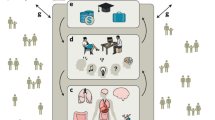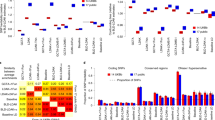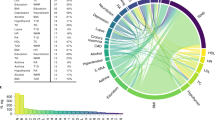Abstract
Meta-analyses of genome-wide association studies, which dominate genetic discovery, are based on data from diverse historical time periods and populations. Genetic scores derived from genome-wide association studies explain only a fraction of the heritability estimates obtained from whole-genome studies on single populations, known as the ‘hidden heritability’ puzzle. Using seven sampling populations (n = 35,062), we test whether hidden heritability is attributed to heterogeneity across sampling populations and time, showing that estimates are substantially smaller across populations compared with within populations. We show that the hidden heritability varies substantially: from zero for height to 20% for body mass index, 37% for education, 40% for age at first birth and up to 75% for number of children. Simulations demonstrate that our results are more likely to reflect heterogeneity in phenotypic measurement or gene–environment interactions than genetic heterogeneity. These findings have substantial implications for genetic discovery, suggesting that large homogenous datasets are required for behavioural phenotypes and that gene–environment interaction may be a central challenge for genetic discovery.
This is a preview of subscription content, access via your institution
Access options
Access Nature and 54 other Nature Portfolio journals
Get Nature+, our best-value online-access subscription
$29.99 / 30 days
cancel any time
Subscribe to this journal
Receive 12 digital issues and online access to articles
$119.00 per year
only $9.92 per issue
Buy this article
- Purchase on Springer Link
- Instant access to full article PDF
Prices may be subject to local taxes which are calculated during checkout





Similar content being viewed by others
References
Visscher, P. M. et al. 10 years of GWAS discovery: biology, function, and translation. Am. J. Hun. Genet. 101, 5–22 (2017).
Manolio, T. A. et al. Finding the missing heritability of complex diseases. Nature 461, 747–753 (2009).
Witte, J. S., Visscher, P. M. & Wray, N. R. The contribution of genetic variants to disease depends on the ruler. Nat. Rev. Genet. 15, 765–776 (2014).
Polderman, T. J. C. et al. Meta-analysis of the heritability of human traits based on fifty years of twin studies. Nat. Genet. 47, 702–709 (2015).
Okbay, A. et al. Genome-wide association study identifies 74 loci associated with educational attainment. Nature 533, 539–542 (2016).
Barban, N. et al. Genome-wide analysis identifies 12 loci influencing human reproductive behavior. Nat. Genet. 48, 1462–1472 (2016).
Yang, J. et al. Common SNPs explain a large proportion of the heritability for human height. Nat. Genet. 42, 565–569 (2010).
Yang, J., Lee, S. H., Goddard, M. E. & Visscher, P. M. GCTA: a tool for genome-wide complex trait analysis. Am. J. Hum. Genet. 88, 76–82 (2011).
Tropf, F. C. et al. Human fertility, molecular genetics, and natural selection in modern societies. PLoS ONE 10, e0126821 (2015).
Rietveld, C. A. et al. GWAS of 126,559 individuals identifies genetic variants associated with educational attainment. Science 340, 1467–1471 (2013).
Zhu, Z. et al. Dominance genetic variation contributes little to the missing heritability for human complex traits. Am. J. Hum. Genet. 96, 377–385 (2015).
Zuk, O. & Hechter, E. The mystery of missing heritability: genetic interactions create phantom heritability. Proc. Natl Acad. Sci. USA 109, 1193–1198 (2012).
Yang, J. et al. Genetic variance estimation with imputed variants finds negligible missing heritability for human height and body mass index. Nat. Genet. 47, 1114–1120 (2015).
Felson, J. What can we learn from twin studies? A comprehensive evaluation of the equal environments assumption. Soc. Sci. Res. 43, 184–199 (2014).
Wray, N. R. et al. Pitfalls of predicting complex traits from SNPs. Nat. Rev. Genet. 14, 507–515 (2013).
Mills, M. C., Rindfuss, R. R., McDonald, P. & te Velde, E. Why do people postpone parenthood? Reasons and social policy incentives. Hum. Reprod. Update 17, 848–860 (2011).
De Vlaming, R. et al. Meta-GWAS Accuracy and Power (MetaGAP) calculator shows that hiding heritability is partially due to imperfect genetic correlations across studies. PLOS Genet. 13, e1006495 (2017).
Robinson, M. R. et al. Genotype-covariate interaction effects and the heritability of adult body mass index. Nat. Genet. 49, 1174–1181 (2017).
Yang, J. et al. Genome-wide genetic homogeneity between sexes and populations for human height and body mass index. Hum. Mol. Genet. 24, 7445–7449 (2015).
Conley, D., Laidley, T. M., Boardman, J. D., Domingue, B. W. & Boardman, J. D. Changing polygenic penetrance on phenotypes in the 20th century among adults in the US population. Sci. Rep. 6, 30348 (2016).
Walter, S. et al. Association of a genetic risk score with body mass index across different birth cohorts. JAMA 316, 63–69 (2016).
Mehta, D. et al. Evidence for genetic overlap between schizophrenia and age at first birth in women. JAMA Psychiatry 73, 497–505 (2016).
Visscher, P. M. et al. Statistical power to detect genetic (co) variance of complex traits using SNP data in unrelated samples. PLoS Genet. 10, e1004269 (2014).
Briley, D. A., Tropf, F. C. & Mills, M. C. What explains the heritability of completed fertility? Evidence from two large twin studies. Behav. Genet. 47, 36–51 (2017).
Tropf, F. C. & Mandemakers, J. J. Is the association between education and fertility postponement causal? The role of family background factors. Demography 54, 71–91 (2017).
Mills, M. C. Introducing Survival and Event History Analysis (Sage, Thousand Oaks, CA, 2011).
Tropf, F. C., Barban, N., Mills, M. C., Snieder, H. & Mandemakers, J. J. Genetic influence on age at first birth of female twins born in the UK, 1919–68. Popul. Stud. (Camb.) 69, 129–145 (2015).
Stearns, S. C., Byars, S. G., Govindaraju, D. R. & Ewbank, D. Measuring selection in contemporary human populations. Nat. Rev. Genet. 11, 611–622 (2010).
Courtiol, A., Tropf, F. C. & Mills, M. C. When genes and environment disagree: making sense of trends in recent human evolution. Proc. Natl Acad. Sci. USA 113, 7693–7695 (2016).
Purcell, S. M. et al. PLINK: a tool set for whole-genome association and population-based linkage analyses. Am. J. Hum. Genet. 81, 559–575 (2007).
Lee, S. H., Yang, J., Goddard, M. E., Visscher, P. M. & Wray, N. R. Estimation of pleiotropy between complex diseases using single-nucleotide polymorphism-derived genomic relationships and restricted maximum likelihood. Bioinformatics 28, 2540–2542 (2012).
Visscher, P. M., Yang, J. & Goddard, M. E. A commentary on ‘common SNPs explain a large proportion of the heritability for human height’ by Yang et al. (2010). Twin Res. Hum. Genet. 13, 517–524 (2010).
International HapMap 3 Consortium. Integrating common and rare genetic variation in diverse human populations. Nature 467, 52–58 (2010).
Balbo, N., Billari, F. C. & Mills, M. C. Fertility in advanced societies: a review of research. Eur. J. Popul. 29, 1–38 (2013).
Van de Kaa, D. J. Europe’s second demographic transition. Popul. Bull. 42, 1–59 (1987).
Sobotka, T. Is lowest‐low fertility in europe explained by the postponement of childbearing? Popul. Dev. Rev. 30, 195–220 (2004).
Price, A. L. et al. Principal components analysis corrects for stratification in genome-wide association studies. Nat. Genet. 38, 904–909 (2006).
Snijders, T. A. B. Multilevel Analysis (Springer, Berlin, 2011).
Domingue, B. W. et al. Genome-wide estimates of heritability for social demographic outcomes. Biodemography Soc. Biol. 62, 1–18 (2016).
Verweij, R. M. et al. Sexual dimorphism in the genetic influence on human childlessness. Eur. J. Hum. Genet. 25, 1067–1074 (2017).
Mills, M. C. & Tropf, F. C. The biodemography of fertility: a review and future research frontiers. Kolner Z. Soz. Sozpsychol. 55, 397–424 (2016).
Visscher, P. M., Hill, W. G. & Wray, N. R. Heritability in the genomics era—concepts and misconceptions. Nat. Rev. Genet. 9, 255–266 (2008).
Wray, N. R. & Maier, R. Genetic basis of complex genetic disease: the contribution of disease heterogeneity to missing heritability. Curr. Epidemiol. Rep. 1, 220–227 (2014).
Acknowledgements
Funding was provided by the European Research Council Consolidator Grant SOCIOGENOME (615603) and the UK Economic and Social Research Council/National Centre for Research Methods SOCGEN grant (ES/N011856/1), as well as the Wellcome Trust Institutional Strategic Support Fund and John Fell Fund (awarded to M.C.M.). The ARIC study is carried out as a collaborative study supported by the United States National Heart, Lung, and Blood Institute (HHSN268201100005C, HHSN268201100006C, HHSN268201100007C, HHSN268201100008C, HHSN268201100009C, HHSN268201100010C, HHSN268201100011C and HHSN268201100012C). The EGCUT study was supported by European Union Horizon 2020 grants 692145, 676550 and 654248, Estonian Research Council Grant IUT20-60, the Nordic Information for Action e-Science Center, the European Institute of Innovation and Technology–Health, National Institutes of Health (NIH) BMI grant 2R01DK075787-06A1 and the European Regional Development Fund (project 2014-2020.4.01.15-0012 GENTRANSMED). The Health and Retirement Study is supported by the United States National Institute on Aging (U01AG009740). The genotyping was funded separately by the United States National Institute on Aging (RC2 AG036495 and RC4 AG039029) and was conducted by the NIH Center for Inherited Disease Research (CIDR) at Johns Hopkins University. Genotyping quality control and final preparation of the HRS data were performed by the Genetics Coordinating Center at the University of Washington. The LifeLines Cohort Study and generation and management of GWAS genotype data for the LifeLines Cohort Study were supported by the Netherlands Organisation for Scientific Research (NWO 175.010.2007.006), Economic Structure Enhancing Fund of the Dutch government, Ministry of Economic Affairs, Ministry of Education, Culture and Science, Ministry for Health, Welfare and Sports, Northern Netherlands Collaboration of Provinces, Province of Groningen, University Medical Center Groningen, University of Groningen, Dutch Kidney Foundation and Dutch Diabetes Research Foundation. The Swedish Twin Registry (TWINGENE) was supported by the Swedish Research Council (M-2005-1112), GenomEUtwin (EU/QLRT-2001-01254 and QLG2-CT-2002-01254), NIH DK U01-066134, Swedish Foundation for Strategic Research and Heart and Lung Foundation (20070481). The TwinsUK study was funded by the Wellcome Trust and European Community’s Seventh Framework Programme (FP7/2007–2013). The study also received support from the National Institute for Health Research-funded BioResource, Clinical Research Facility and Biomedical Research Centre based at Guy’s and St Thomas’ NHS Foundation Trust in partnership with King’s College London. SNP genotyping was performed by The Wellcome Trust Sanger Institute and National Eye Institute via the NIH CIDR. For the QIMR data, funding was provided by the Australian National Health and Medical Research Council (241944, 339462, 389927, 389875, 389891, 389892, 389938, 442915, 442981, 496739, 552485 and 552498), Australian Research Council (A7960034, A79906588, A79801419, DP0770096, DP0212016 and DP0343921), FP-5 GenomEUtwin Project (QLG2-CT-2002-01254) and NIH (grants AA07535, AA10248, AA13320, AA13321, AA13326, AA14041, DA12854 and MH66206). A portion of the genotyping on which the QIMR study was based (the Illumina 370 K scans) was carried out at the CIDR through an access award to the authors’ late colleague R. Todd (Psychiatry, Washington University School of Medicine, St Louis). Imputation was carried out on the Genetic Cluster Computer, which is financially supported by the Netherlands Organisation for Scientific Research (NWO 480-05-003). The funders had no role in study design, data collection and analysis, decision to publish or preparation of the manuscript.
Author information
Authors and Affiliations
Contributions
F.C.T., S.H.L. and M.C.M. developed the study concept and design. M.R.R. and F.C.T. developed the concept for and performed the simulation studies. F.C.T., R.M.V., G.S. and C.R. performed the data analysis and visualization. T.E., A.M., S.E.M., N.G.M., A.N., S.H.L. and A.B. provided data and input on data analysis and interpretation, and imputed the data. F.C.T., M.C.M., S.H.L., M.R.R., H.S., G.S. and R.d.V. drafted the manuscript. F.C.T., M.C.M., M.R.R., R.M.V., G.S., P.J.v.d.M., R.d.V., N.G.M., N.B., D.A.B., C.R. and R.H. revised the manuscript. All authors approved the final version of the manuscript for submission.
Corresponding author
Ethics declarations
Competing interests
The authors declare no competing interests.
Additional information
Publisher’s note: Springer Nature remains neutral with regard to jurisdictional claims in published maps and institutional affiliations.
Electronic supplementary material
Supplementary Information
Supplementary Tables 1–8, Supplementary Notes 1–4, Supplementary References 1–9
Rights and permissions
About this article
Cite this article
Tropf, F.C., Lee, S.H., Verweij, R.M. et al. Hidden heritability due to heterogeneity across seven populations. Nat Hum Behav 1, 757–765 (2017). https://doi.org/10.1038/s41562-017-0195-1
Received:
Accepted:
Published:
Issue Date:
DOI: https://doi.org/10.1038/s41562-017-0195-1
This article is cited by
-
Cross-ancestry genetic architecture and prediction for cholesterol traits
Human Genetics (2024)
-
Combining the strengths of Dutch survey and register data in a data challenge to predict fertility (PreFer)
Journal of Computational Social Science (2024)
-
Unraveling phenotypic variance in metabolic syndrome through multi-omics
Human Genetics (2024)
-
Genetic liability to age at first sex and birth in relation to cardiovascular diseases: a Mendelian randomization study
BMC Medical Genomics (2023)
-
A method for an unbiased estimate of cross-ancestry genetic correlation using individual-level data
Nature Communications (2023)



